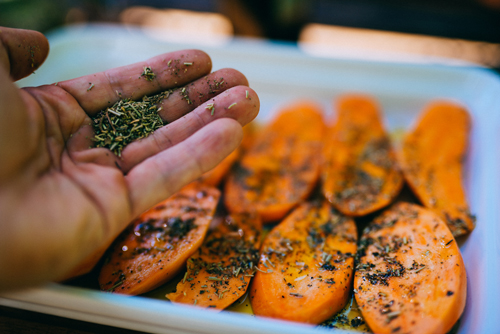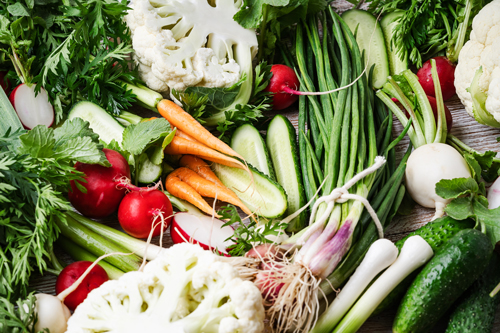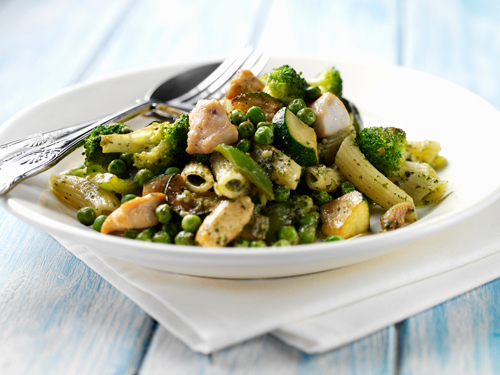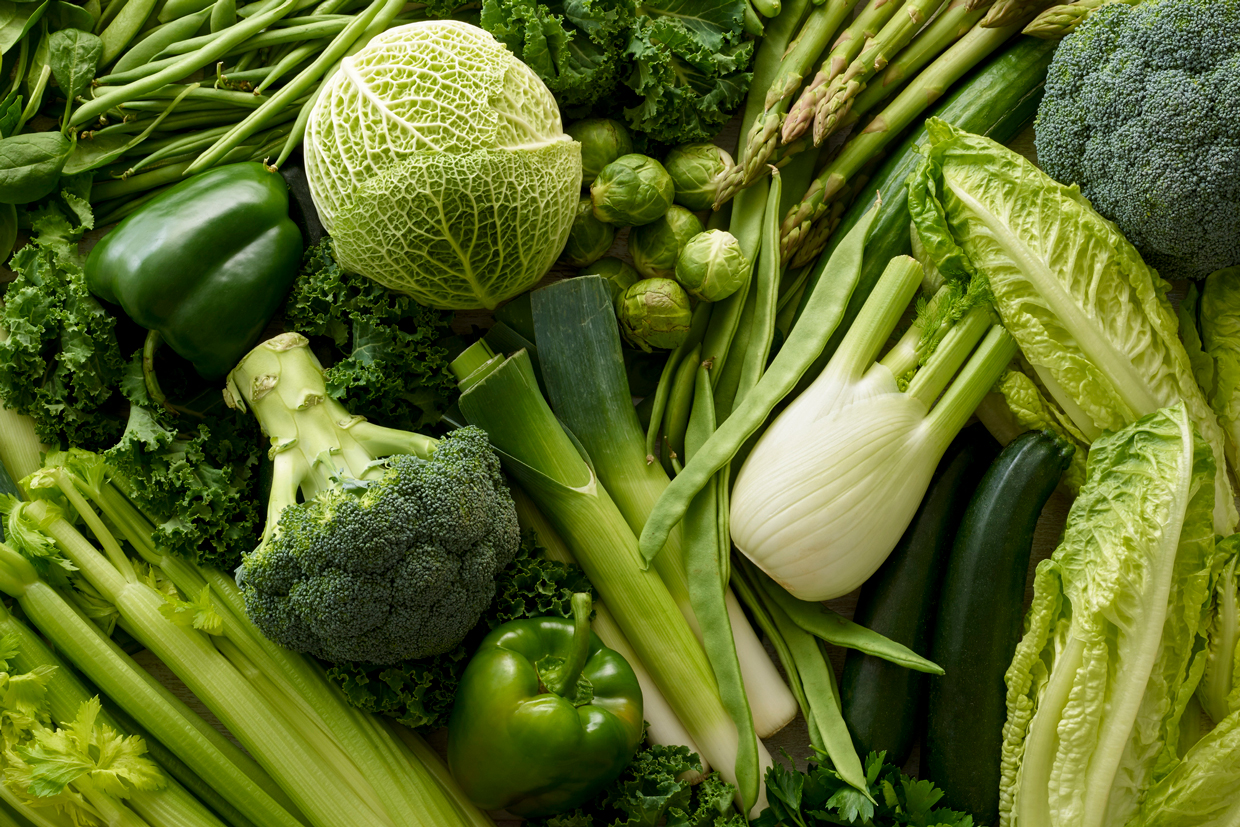More than 90 percent of American adults aren’t consuming enough vegetables each day. In general, the recommended amount is three to five servings of vegetables per day. “A serving means one cup raw or half cup cooked,” explains Jamie Feit, MS, RD and expert at testing.com. “If we don’t consume the RDA (recommended daily amount) of vegetables, we aren’t meeting the recommended amount of fiber. Fiber decreases chronic diseases, promotes satiety and helps with weight loss, and keeps our gut microbiome healthy,” explains Feit. Vegetables also pack in a variety of antioxidants, vitamins, and minerals, which can’t be replaced by popping a daily supplement. So how do we increase our intake in flavorful, easy, cost-effective ways?

Thankfully there aren’t really “rules” around how you need to consume your veggies. You can get your whole day’s worth at one meal or spread throughout the day, says Feit. (For more information on what constitutes a vegetable and daily intake based on age and gender, click here.) The goal is to have a variety every day: It’s great if you love carrots, but a variety of colorful veggies give you the most nutritional benefits. And, even if you’ve met your daily required amount, there’s no harm in trying to increase your vegetable intake whenever possible — there’s no such thing as too much nutrition!
Meet the Experts
Jamie Feit, MS, RD, is an expert at testing.com.
Jen Bruning, MS, RDN, LDN, is a spokesperson for the Academy of Nutrition and Dietetics.
Breakfast Ideas
An easy go-to: Eggs. Scramble them with any vegetable that you’d like: spinach, kale, mushrooms, bell pepper, onions, etc. Pack in a few more veggies by topping your eggs with avocado and salsa. Feit favorite recipe is mixing sautéed veggies with eggs, baking them in a muffin cup, then freezing them for an easy, on-the-go meal. (See the recipe here.) Avocado smothered on whole grain or sourdough toast is another easy way to incorporate some fiber.
Next go-to: Smoothie. If you don’t want to go full-on green with celery, mint, and spinach, then choose one green, like kale, to mix in with frozen fruit and a bit of Greek yogurt or non-dairy milk. Is there anything that doesn’t belong in a smoothie? “Veggies you’d almost always eat cooked — like squash, eggplant, artichokes, potatoes — won’t blend up well and they won’t taste good as a smoothie ingredients,” says Jen Bruning, MS, RDN, LDN, and spokesperson for the Academy of Nutrition and Dietetics.

Lunch Time Ideas
“One easy way to have more vegetables in your lunch is to cook more veg for dinner. Then simply pack up the leftovers for lunch the next day,” says Bruning. Beyond that, choose veg-laden, broth-based soups, salads (obviously), a wrap full of shredded carrots, beets, lettuce, tomato and crunchy purple cabbage, or a quesadilla with beans, cheese, spinach, and corn with avocado and tomato on top.
If you eat lunch out most days, head to places that let you build your own meal, says Bruning. “These are great because they provide enough fresh options to add variety to your meals and you can ask for extra veggies.” If you’re heading to a food court, which has a notorious reputation for junk food, there are still healthy options to be had. Look for a mixed vegetable bowl or rice paper rolls with vegetables and protein (skipping any deep-fried options). At smoothie shops, look for an option that includes a green like kale. At a pizza place, opt for a veggie-topped pizza slice and a Greek side salad.

Snack Ideas
Carrot sticks or baby carrots, trimmed radishes, celery and cucumber sticks, jicama, or snap peas dipped in a bean- or yogurt-based dip make adding veggies to your diet a breeze,” says Bruning. “Or opt for a small salad or cup of veggie-rich soup.” But she cautions against veggie chips from a bag. “Some contain very little nutrition or have been fried like potato chips.” A great packaged, to-go snack to grab instead? Dried seaweed, according to Feit. They contain a variety of vitamins, plus zinc, calcium, and folate. Or finish the other half of that smoothie you whizzed up at breakfast.
Dinner Ideas
For starters, think: tomato sauce. Get out the food processor and finely chop onion, celery, and mushroom, shred zucchini, carrots, beets and anything else your heart desires. Then sauté together in some olive oil, add some tomato passata and Italian herbs and you have yourself a nutritious sauce that can work in lasagna, pasta, or with meatballs. Tomato sauce is also very convenient to make in a huge batch and freeze some for later. Our pros recommend some other meals that can incorporate half a dozen or more vegetables, including chili, enchiladas, soups, stews, frittatas, stir fries, curries and other traditional dishes from around the world. Even pizza can be an opportunity to load up on vegetables, whether you incorporate cauliflower into your crust or top it with onions, peppers, mushrooms, olives, spinach, and herbs.
If you find you rely on starches at dinnertime, try swapping in a starchy vegetable instead. So, leave out the french fries and add in purple potatoes; leave off the noodles and swap in spaghetti squash “and suddenly you’re eating more veg!” says Bruning. Not all potatoes are off the table, however. “They get a bad rap! Potatoes are filled with important nutrients,” she explains, adding that how much we eat and how they are prepared are the big caveats with spuds. “High fat and sodium French fries or chips served in large portions aren’t very supportive of health.” But a baked potato, including the fibrous skin, served with Greek yogurt and turkey chili is a solid, nutritious, and filling option. If you crave the crispiness of a fried potato, consider investing in an air-fryer so you minimize the amount of oil you need, but you still get that amazing texture.

“Tricks” to Avoid
Bruning advocates against hiding vegetable to get the family (particularly kids) to eat them. “People should know what they’re eating so that they can form positive associations with foods they thought they didn’t love previously.” Also avoid dowsing vegetables in a cheese sauce or salad dressing. “This adds calories and fat, which is not the best for decreasing weight or chronic disease. However, the vegetables still have fiber, even when consumed this way,” says Feit. Look for a happy medium. Instead of a salad dressing with tons of food additives, try extra virgin olive oil and lemon juice. The goal is overall nutritious eating, not eating more vegetables no matter what.
Managing the Cost
For starters, you need to be flexible based on what’s in season and on sale. You may want to make an asparagus and goat’s cheese tart in fall, but it’s not asparagus season so it won’t be fresh or cheap. If there aren’t good deals on fresh produce, consider frozen. “They are cut and frozen very quickly after being harvested, which preserves lots of nutrients,” explains Bruning. Or canned, opting for low-sodium ones.
The grocery store isn’t the only place to get vegetables. Look for alternatives like the local farmer’s market or even consider growing your own. If you get your hands on lots of something at a low price, freeze the rest for another time or put it in a recipe that you freeze.
Eating Out
Even though eating at restaurants is a fun way to try new cuisines and socialize, studies show that dining out is associated with making unhealthy decisions around food. Check out the menu beforehand so you can come up with a game plan and be able to readily order healthy options. If you find that they don’t have anything suitable on the menu, it’ll give you time to seek out a different restaurant choice. Once you’re there, ask the waiter if they can substitute unhealthy sides like fries or chips for grilled vegetables.
Get Inspired and Be Prepared

Meal planning and batch cooking can be your best friends for healthy eating. “Take one day to stock your fridge with cut-up or roasted veggies,” says Feit. “It makes it that much easier to consume them.”
Challenge yourself (or your family) to try one new vegetable each week until you’ve tried almost everything in the produce department. You never know what you might love. Also, try new recipes. If nothing else, you can find a fritter recipe for just about any vegetable.
Look at Pinterest for inspiration or follow health gurus on Instagram, including Bari Stricoff, Dr. Megan Rossi, Marisa Moore, Dr. Hazel Wallace, May Zhu, Dawn Jackson Moore, and Flourish Heights. They offer meal ideas with a bounty of goodness.
Finally, stay positive and stick with it: “Don’t feel defeated if you don’t get all of your vegetables in every single day,” says Bruning. “Start with easy changes, let your body and taste buds adjust to these new foods, and be willing to try new things in new ways.” You’ll be a 10 percent-er before you know it.
We only recommend products we have independently researched, tested, and loved. If you purchase a product found through our links, Sunday Edit may earn an affiliate commission.







